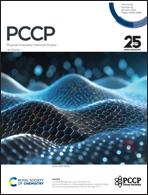A rotational spectroscopy study of microsolvation effects on intramolecular proton transfer in trifluoroacetylacetone–(H2O)1–3†
Abstract
Trifluoroacetylacetone (TFAA) has two enol forms, which can switch to each other via proton transfer. While much attention has been paid to their conformational preferences, the influence of microsolvation on regulating the proton position remains unexplored. Herein, we report the rotational spectra of trifluoroacetylacetone–(water)n (n = 1–3) investigated by chirped pulse Fourier transform microwave spectroscopy in the 2–8 GHz frequency range. Two conformers were identified for both TFAA–H2O and TFAA–(H2O)2, while only one conformer was characterized for TFAA–(H2O)3. The results indicate that water binding on the CH3 side stabilizes the enolF form, whereas water binding on the CF3 side stabilizes the enolH form. The enolF form predominates over the enolH form in these hydrated complexes, which contrasts with the fact that only enolH exists in isolated TFAA. EnolH becomes preferred only when water inserts itself into the intramolecular hydrogen bond. Instanton theory calculations reveal that the proton transfer reaction is dominated by quantum tunneling at low temperatures, leading to the stable existence of only one enol form in each configuration of the hydrated clusters.

- This article is part of the themed collection: Size effects in chemistry & physics of atomic & molecular clusters, nanoparticles & nanostructures


 Please wait while we load your content...
Please wait while we load your content...